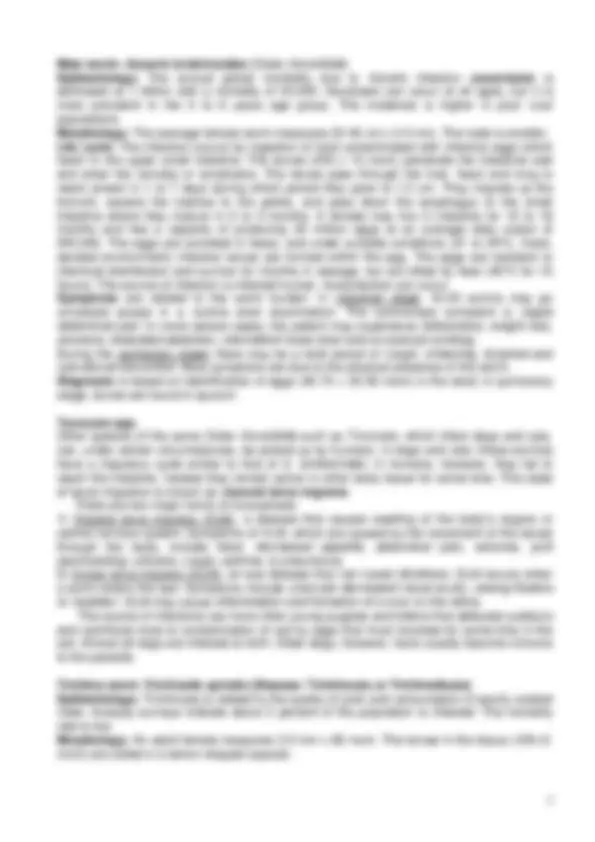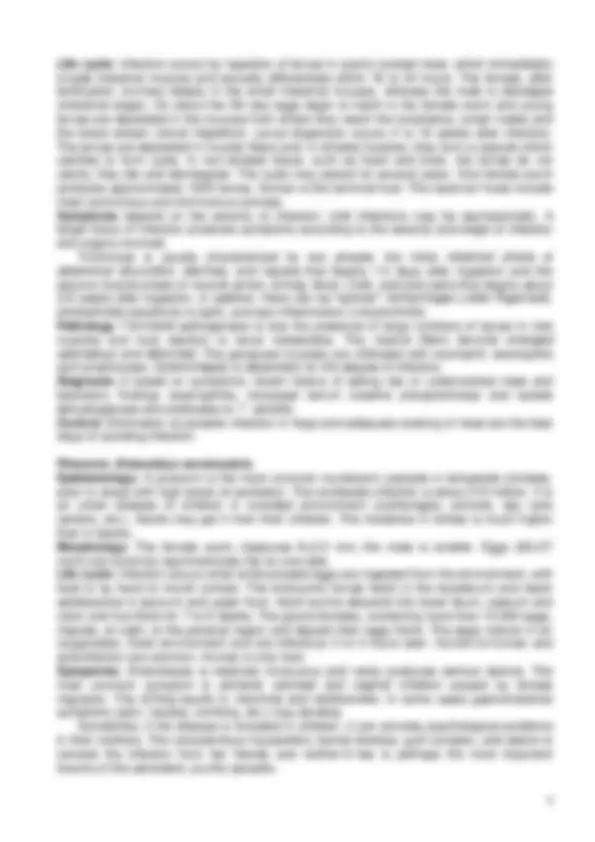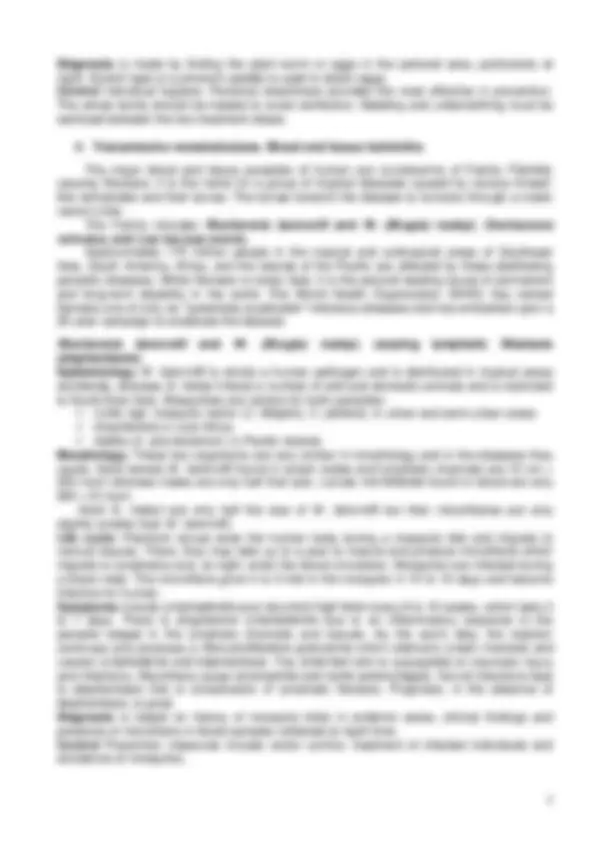





Study with the several resources on Docsity

Earn points by helping other students or get them with a premium plan


Prepare for your exams
Study with the several resources on Docsity

Earn points to download
Earn points by helping other students or get them with a premium plan
Community
Ask the community for help and clear up your study doubts
Discover the best universities in your country according to Docsity users
Free resources
Download our free guides on studying techniques, anxiety management strategies, and thesis advice from Docsity tutors
Ancylostoma duodenale or Hookworm of phylum Nemathelminthes
Typology: Study notes
1 / 6

This page cannot be seen from the preview
Don't miss anything!




Lecture: Medical Helminthology. Phylum Nemathelminthes (Roundworms). Class Nematoda
1. Roundworms: diversity and ecological role 2. General characteristics of Class Nematoda 3. Roundworms – human parasites. Examples of geohelminthes, biohelminthes and contact helminthes 4. Transmissive nematodosises. Blood and tissue helminths 1. Roundworms: diversity and ecological role
Roundworms, or nematodes , are a group of invertebrates (animals having no backbone) with long cylindrical bodies that are round in cross-section. Most roundworm eggs or larvae are found in soil and can be picked up on the hands and transferred to the mouth or can enter through the skin. Nematodes are almost unbelievably abundant. A number of described species is around 12,000, but too little attention has been paid to these animals and the true number may be closer to 500,000. Some species are generalists, occuring across wide areas and in many habitats; others are much more specialized (e.g., nematode that is known only from felt coasters placed under beer mugs in a few towns in Germany or nematode of the placentas of sperm whales). Many nematodes are free-living and play critical ecological roles as decomposers and predators on microorganisms. They are ubiquitous in freshwater, marine, and terrestrial environments. Different species feed on materials as varied as algae, fungi, small animals, fecal matter, dead organisms and living tissues. Free-living marine nematodes play an important role in the decomposition process, aid in recycling of nutrients in marine environments and are sensitive to changes in the environment caused by pollution. And nematodes also include parasitic species, a number of which affect humans directly or indirectly through their domestic animals. Some thrive as parasites in moist tissues of plants and in body fluids and tissues of animals. Most species serious agricultural pests that attack bark and forest trees (affecting roots of plants). Other nematodes parasitize animals, e.g., hookworms attach to intestine wall and suck blood; heartworms spread by mosquitoes, infectious to humans; deadly to dogs.
Diversity of Nematodes Helminth species Numbers (million) Distribution
Ascaris lumbricoides 1,472.00 Worldwide; developing countries
Ancylostoma duodenale and Necator americanus 1,298.00^ Worldwide; developing countries
Trichuris trichiura 1,049.00 Worldwide; developing countries
Dracnunculus medinensis 0.08 Sub-Sahara Africa; Yemen
Strongyloides stercoralis 70.00 Worldwide (warmer countries)
Wuchereria bancrofti 107.00 Asia; Central and South America; Sub-Saharan Africa; West Pacific countries
Brugia malayi and Brugia timori 13.^
E. Indonesia islands; Philippines; S.E. Asia; Southern China; India
Onchocerca volvulus 17.66 Central and South America; Sub-Saharan Africa; Yemen
Loa loa 13.00 West and central Sub-Saharan Africa
2. General characteristics of Class Nematoda
System Type Characteristics
Appearance
Bilateral symmetry, with long, cylindrical bodies. They range in size from those plainly visible to the naked eye to those several meters long and visible only under a microscope.
Muscular- Skeletal
A roundworm has no skeleton. Body is surrounded by a strong, flexible non- cellular layer called a cuticle. The cuticle is secreted by and covers a layer of epidermal cells. Near the body wall but under the epidermal cells are muscle cells; they run in the longitudinal direction only. In free-living species development consists of 4 moults.
Digestion They have definite digestive system that runs the length of their bodies. It consists of 3 sections : foregut, midgut and hindgut
Nervous The system is simple, with two nerve cords: a main ventral nerve cord and a smaller dorsal nerve cord.
Circulation A roundworm has no heart or formal blood vessels.
Respiration A roundworm has no formal respiratory system.
Excretion A roundworm has an anus at its rear end and a series of excretory tubes that end in an excretory pore. Nematodes don’t have flame cells.
Reproduction
Roundworms are diecious ( separated sexes : male and female) and reproduces sexually. Males are usually shorter than females (often much smaller) and often have a characteristically bent tail for holding the female for copulation. Female roundworms can lay 100000 to 300000 eggs a day
3. Roundworms – human parasites. Examples of geohelminthes, biohelminthes and contact helminthes
An infection caused by roundworms is called nematodosis. As with other parasitic diseases, roundworm infections are more common in warm climates than in cooler, temperate areas. Many nematodosises result from human carelessness and a lack of appropriate personal hygiene and sanitation measures. Most roundworm eggs or larvae are found in the soil and can be picked up on the hands and transferred to the mouth ( peroral way ). Also infection occurs variously by eating uncooked meat with larvae in it (e.g., that causes trichinosis), by entrance into unprotected cuts or directly through the skin ( percutaneous way ), by transfer via blood-sucking insects ( transmissive inoculative way ), and so forth. Thus, the best solution to the problem rests in preventing these infections rather than in curing them. Depending on the features of life cycle helmintic parasites can be classified as follows –
1. geohelminthes which develop without alternation of hosts and part of their life cycle passes in soil, e.g., Maw worm ( Ascaris lumbricoides ), Toxocara spp. 2. biohelminthes which develop with alternation of hosts, e.g., Trichina worm ( Trichinella spiralis ) Parasitic forms often have quite complicated life cycles, moving between several different hosts or locations in a host's body. 3. contact helminthes in which all stages of parasite development pass in human organism. Direct contact with patient and host may occur by physical contact (through handgrip) or indirectly by contaminated objects (through pencils, toys), e.g. Pinworm (Enterobius vermicularis).
Life cycle: Infection occurs by ingestion of larvae in poorly cooked meat, which immediately invade intestinal mucosa and sexually differentiate within 18 to 24 hours. The female, after fertilization, burrows deeply in the small intestinal mucosa, whereas the male is dislodged (intestinal stage). On about the 5th day eggs begin to hatch in the female worm and young larvae are deposited in the mucosa from where they reach the lymphatics, lymph nodes and the blood stream ( larval migration ). Larval dispersion occurs 4 to 16 weeks after infection. The larvae are deposited in muscle fibers and, in striated muscles, they form a capsule which calcifies to form cysts. In non-striated tissue, such as heart and brain, the larvae do not calcify; they die and disintegrate. The cysts may persist for several years. One female worm produces approximately 1500 larvae. Human is the terminal host. The reservoir hosts include most carnivorous and omnivorous animals. Symptoms depend on the severity of infection: mild infections may be asymptomatic. A larger bolus of infection produces symptoms according to the severity and stage of infection and organs involved. Trichinosis is usually characterized by two phases: the initial intestinal phase of abdominal discomfort, diarrhea, and nausea that begins 1-2 days after ingestion and the second muscle phase of muscle aches, itching, fever, chills, and joint pains that begins about 2-8 weeks after ingestion. In addition, there can be "splinter" hemorrhages under fingernails , photophobia (sensitivity to light), and eye inflammation ( conjunctivitis ). Pathology Trichinella pathogenesis is due the presence of large numbers of larvae in vital muscles and host reaction to larval metabolites. The muscle fibers become enlarged edematous and deformed. The paralyzed muscles are infiltrated with neutrophil, eosinophils and lymphocytes. Splenomegaly is dependent on the degree of infection. Diagnosis is based on symptoms, recent history of eating raw or undercooked meat and laboratory findings (eosinophilia, increased serum creatine phosphokinase and lactate dehydrogenase and antibodies to T. spiralis ). Control: Elimination of parasite infection in hogs and adequate cooking of meat are the best ways of avoiding infection.
Pinworm: Enterobius vermicularis Epidemiology: A pinworm is the most common roundworm parasite in temperate climates, even in areas with high levels of sanitation. The worldwide infection is about 210 million. It is an urban disease of children in crowded environment (orphanages, schools, day care centers, etc.). Adults may get it from their children. The incidence in whites is much higher than in blacks. Morphology: The female worm measures 8×0.5 mm; the male is smaller. Eggs (60× mcm) are ovoid but asymmetrically flat on one side. Life cycle: Infection occurs when embryonated eggs are ingested from the environment, with food or by hand to mouth contact. The embryonic larvae hatch in the duodenum and reach adolescence in jejunum and upper ilium. Adult worms descend into lower ileum, caecum and colon and live there for 7 to 8 weeks. The gravid females, containing more than 10,000 eggs, migrate, at night, to the perianal region and deposit their eggs there. The eggs mature in an oxygenated, moist environment and are infectious 3 to 4 hours later. Human-to-human and autoinfection are common. Human is only host. Symptoms: Enterobiasis is relatively innocuous and rarely produces serious lesions. The most common symptom is perianal, perineal and vaginal irritation caused by female migration. The itching results in insomnia and restlessness. In some cases gastrointestinal symptoms (pain, nausea, vomiting, etc.) may develop. Sometimes, if the disease is revealed in children, it can provoke psychological problems in their mothers. The conscientious housewife's mental distress, guilt complex, and desire to conceal the infection from her friends and mother-in-law is perhaps the most important trauma of this persistent, pruritic parasite.
Diagnosis is made by finding the adult worm or eggs in the perianal area, particularly at night. Scotch tape or a pinworm paddle is used to obtain eggs. Control Individual hygiene. Personal cleanliness provides the most effective in prevention. The whole family should be treated to avoid reinfection. Bedding and underclothing must be sanitized between the two treatment doses.
4. Transmissive nematodosises. Blood and tissue helminths
The major blood and tissue parasites of human are roundworms of Family Filariida , causing filiariasis. It is the name for a group of tropical diseases caused by various thread- like nematodes and their larvae. The larvae transmit the disease to humans through a insect vector’s bite. The Family includes Wuchereria bancrofti and W. (Brugia) malayi , Onchocerca volvulus , and Loa loa (eye worm). Approximately 170 million people in the tropical and subtropical areas of Southeast Asia, South America, Africa, and the islands of the Pacific are affected by these debilitating parasitic diseases. While filariasis is rarely fatal, it is the second leading cause of permanent and long-term disability in the world. The World Health Organization (WHO) has named filariasis one of only six "potentially eradicable" infectious diseases and has embarked upon a 20-year campaign to eradicate the disease.
Wuchereria bancrofti and W. (Brugia) malayi , causing lymphatic filiariasis (elephantiasis) Epidemiology W. bancrofti is strictly a human pathogen and is distributed in tropical areas worldwide, whereas B. malayi infects a number of wild and domestic animals and is restricted to South-East Asia. Mosquitoes are vectors for both parasites: Culex spp. mosquito vector ( C. fatigans, С. pipiens), in urban and semi-urban areas Anophelines in rural Africa Aedes ( A. polynesiensis ) in Pacific Islands Morphology: These two organisms are very similar in morphology and in the diseases they cause. Adult female W. bancrofti found in lymph nodes and lymphatic channels are 10 cm × 250 mcm whereas males are only half that size. Larvae microfilariae found in blood are only 260 ×10 mcm. Adult B. malayi are only half the size of W. bancrofti but their microfilariae are only slightly smaller than W. bancrofti. Life cycle: Filariform larvae enter the human body during a mosquito bite and migrate to various tissues. There, they may take up to a year to mature and produce microfilaria which migrate to lymphatics and, at night, enter the blood circulation. Mosquitos are infected during a blood meal. The microfilaria grow 4 to 5 fold in the mosquito in 10 to 14 days and become infective for human. Symptoms include lymphadenitis and recurrent high feve r every 8 to 10 weeks, which lasts 3 to 7 days. There is progressive lymphadenitis due to an inflammatory response to the parasite lodged in the lymphatic channels and tissues. As the worm dies, the reaction continues and produces a fibro-proliferative granuloma which obstructs lymph channels and causes lymphedema and elephantiasis. The stretched skin is susceptible to traumatic injury and infections. Microfilaria cause eosinophilia and some splenomegaly. Not all infections lead to elephantiasis that is complication of lymphatic filariasis. Prognosis, in the absence of elephantiasis, is good. Diagnosis is based on history of mosquito bites in endemic areas, clinical findings and presence of microfilaria in blood samples collected at night-time. Control Prevention measures include vector control, treatment of infected individuals and avoidance of mosquitos.